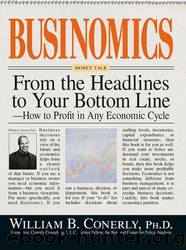Businomics From The Headlines To Your Bottom Line: How to Profit in Any Economic Cycle by Conerly William B

Author:Conerly, William B. [Conerly, William B.]
Language: eng
Format: epub
Tags: epub, ebook
Publisher: F+W Media, Inc.
Published: 2007-04-12T03:00:00+00:00
END-USER INFORMATION
The next part of the monitoring system focuses on the end user. Companies close to the ultimate customer, such as retailers, need to watch proximate influences on consumer spending. Producers of intermediate goods need to watch consumption of the goods that use their product. For instance, the bottle company needs to watch sales of beer and soft drinks. A fabric manufacturer needs to watch apparel sales.
Capital goods manufacturers need to watch the end users of the products that their machinery produces. Thus, the company making semiconductor-chip manufacturing equipment should monitor closely the demand for chips, as swings in that demand will affect the need for new manufacturing equipment.
The general rule, then, is to watch the end user of your product, no matter how far removed from that end user you are.
Those firms that want a detailed forecast of their end users will probably have to subscribe to a service. They are not cheap, but they may be worth the money. The best-known firms in the business are Global Insight, Macroeconomic Advisers, and Economy.com. However, some of the consensus forecasts include projections for major sectors, such as consumer spending. They do not show significant detail, such as consumer spending on clothing and apparel. For that, one needs to pay a forecasting service.
Some industry trade associations employ an economist, or even a team of economists, to produce a forecast for the industry. That's a good starting place, and the forecast is usually proved free to association members. Companies have to understand, however, the constraints under which the association economist works. Oftentimes, associations want a forecast that will paint the industry in the best possible light. In some cases, a forecast of industry conditions is also a forecast of the desirability of customers buying the product. For instance, a forecast of decline in real estate values or stock market prices will discourage investors, so don't expect a trade association whose members sell real estate or investments to issue too gloomy a report. The association is in a conflicted position, and its forecast must be taken with a grain of salt.
The budget-conscious company will emphasize actual data and skip the industry forecast. The appendix to this book shows various government data sources. Trade associations often provide information about activity within their industries. For the pleasure-boat example, we focused on consumer spending. The price information includes a measure of boat prices, but production costs are presented separately. The consumer price information helps the company management understand what is driving changes in sales.
With industry data, companies can estimate their market share, which is critical to interpreting their own performance. Businesses that are unable to find good industry data may have to rely on competitive information. If major competitors are publicly traded companies, watching their financial reports may be valuable. For companies that are not publicly traded, sometimes information can be gleaned from vendors or from regulatory filings.
KEY POINTS
The end user may not be your customer.
Companies need to monitor the buying ability and levels of their end users.
Download
This site does not store any files on its server. We only index and link to content provided by other sites. Please contact the content providers to delete copyright contents if any and email us, we'll remove relevant links or contents immediately.
International Integration of the Brazilian Economy by Elias C. Grivoyannis(74686)
The Radium Girls by Kate Moore(11621)
Turbulence by E. J. Noyes(7700)
Nudge - Improving Decisions about Health, Wealth, and Happiness by Thaler Sunstein(7242)
The Black Swan by Nassim Nicholas Taleb(6763)
Rich Dad Poor Dad by Robert T. Kiyosaki(6174)
Pioneering Portfolio Management by David F. Swensen(6078)
Man-made Catastrophes and Risk Information Concealment by Dmitry Chernov & Didier Sornette(5646)
Zero to One by Peter Thiel(5488)
Secrecy World by Jake Bernstein(4388)
Millionaire: The Philanderer, Gambler, and Duelist Who Invented Modern Finance by Janet Gleeson(4093)
The Age of Surveillance Capitalism by Shoshana Zuboff(3983)
Skin in the Game by Nassim Nicholas Taleb(3965)
The Money Culture by Michael Lewis(3846)
Bullshit Jobs by David Graeber(3828)
Skin in the Game: Hidden Asymmetries in Daily Life by Nassim Nicholas Taleb(3721)
The Dhandho Investor by Mohnish Pabrai(3560)
The Wisdom of Finance by Mihir Desai(3523)
Blockchain Basics by Daniel Drescher(3329)
